List of Florida state symbols
The following are official state symbols of the U.S. state of Florida, as defined by state statutes. The majority of the symbols were chosen after 1950; only the two oldest symbols—the state flower (chosen in 1909), and the state bird (chosen in 1927), and the state nickname (chosen in 1970)—are not listed in the 2010 Florida Statutes.[1] Under the Florida Statutes, all state symbols fall under the purview of the Executive Branch (Title IV), Secretary of State (Chapter 15), as part of the Secretary of State's role as "Chief Cultural Officer."[2]
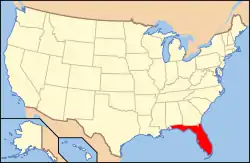
Location of the state of Florida in the United States of America
Insignia
| Type | Symbol | Description | Year | Image | Statute |
|---|---|---|---|---|---|
| Flag | Flag | A red saltire (diagonal cross) on a white background, with the seal of Florida superimposed on the center. The current flag was adopted in 1985, when the state seal was last changed. The basic design, however, dates back to 1900, when the design was approved by voters in a constitutional amendment.[3] | 1985 | 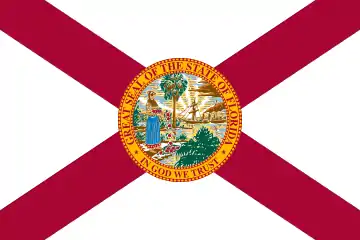 |
15.012[4] |
| State day/week | Pascua Florida | Pascua Florida (Flowery Easter) is usually celebrated on April 2, unless the 2nd falls on a weekend. When it falls on a Saturday or Sunday, the governor may declare either the preceding Friday or following Monday as the state day. According to the 2007 Florida Senate Statutes, the Governor of Florida may annually issue a proclamation designating April 2 as the state day and designating the week of March 27 to April 2 as Pascua Florida week. Pascua Florida commemorates the discovery of Florida by Juan Ponce de León on April 2, 1513. | 1953 | — | 683.06 |
| Motto | "In God We Trust" | The state motto was not adopted until 2006; however, it has appeared on the state seal since 1868. | 2006 | 15.0301[5] | |
| Nickname | Sunshine State | The use of "Sunshine State" has been in place since 1949, when it first appeared on license plates. The nickname was made official by the state legislature in 1970. | 1970 | — [6] | |
| Seal | Seal of Florida | The seal has evolved since 1868, although the basic elements have remained consistent. Florida statute states: "The great seal of the state shall be of the size of the American silver dollar, having in the center thereof a view of the sun's rays over a highland in the distance, a sabal palmetto palm tree, a steamboat on water, and an Indian female scattering flowers in the foreground, encircled by the words 'Great Seal of the State of Florida: In God We Trust.'"[7] The most recent revisions were made in 1985.[8] | 1985 | 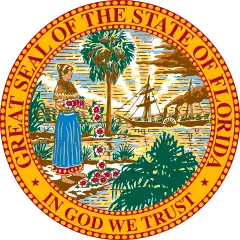 |
15.03[7] |
Florida plants
| Type | Symbol | Description | Year | Image | Statute |
|---|---|---|---|---|---|
| Flower | Orange blossom (Citrus sinensis) |
The fragrant blossoms of the orange tree also represent the largest portion of the state's agriculture industry, which stands behind only tourism as a proportion of the state's economy. | 1909 |  |
– [9] |
| Tree | Sabal palm (Sabal palmetto) |
The sabal palmetto is native to all of Florida, and has been widely used as both a landscape plant and as a food source; hearts of palm are the bud of the tree. | 1953 |  |
15.031[10] |
| Wildflower | Tickseed (Coreopsis) |
There are several native tickseed species to Florida, though many nonnative species are widely planted in highway beautification and roadsides. | 1991 |  |
15.0345[11] |
Fauna
| Type | Symbol | Description | Year | Image | Statute |
|---|---|---|---|---|---|
| Animal | Florida panther (Puma concolor coryi) |
The Florida panther is a critically endangered subspecies of the cougar native to southern Florida. While its numbers have rebounded from a low of about 25 in the early 1990s, there are only about 100 alive in the wild.[12] | 1982 |  |
15.0353[13] |
| Bird | Northern mockingbird (Mimus polyglottos) |
The northern mockingbird, native throughout Florida year-round, is also the state bird for four other southern states. | 1927 |  |
– [14] |
| Butterfly | Zebra longwing (Heliconius charithonia) |
The zebra longwing is a common sight in Florida; the adult butterfly has a long lifespan because it consumes pollen as well as nectar, extending its lifespan from roughly two weeks to about three months.[15] | 1996 |  |
15.0382[16] |
| Fish (fresh water) |
Florida largemouth bass (Micropterus salmoides floridanus) |
The largemouth bass is a sought-after sportfish, which is also the state (freshwater) fish for four other states. The Florida subspecies has smaller scales and grows larger than the northern subspecies.[17] | 1975 |  |
15.036[18] |
| Fish (salt water) |
Atlantic sailfish (Istiophorus platypterus) |
The Atlantic sailfish is sometimes known as Istiophorus albicans,[19] but the Florida legislature used the nomenclature I. Platypterus in the statute naming the state's salt water fish. | 1975 |  |
15.037[20] |
| Heritage cattle breed | Florida Cracker cattle | Florida Cracker cattle is among the oldest breeds in the U.S., descended from Spanish cattle which arrived in the 1500s.[21] | 2018 |  |
15.0527[22] |
| Horse | Florida Cracker Horse | The Florida Cracker Horse is a small horse, descended from horses brought to the state from Spain in the 15th and 16th centuries. | 2008 |  |
15.0526[23] |
| Mammal (marine) |
Florida manatee (Trichechus manatus latirostris) |
The statute naming the manatee as the state marine mammal did not identify the specific species, but the Florida manatee subspecies is the only one normally found in Florida waters.[24] | 1975 |  |
15.038[25] |
| Mammal (salt water) |
Porpoise (Tursiops truncatus) |
The statute naming the porpoise as the state saltwater mammal did not identify the specific species, but it is generally believed that the reference was intended to recognize the bottlenose dolphin.[26] Dolphins are dark gray on top, and very pale gray on their underside, and range in length from 6 to 13 feet. | 1975 |  |
15.038[25] |
| Reptile | American alligator (Alligator mississippiensis) |
1987 |  |
15.0385[27] | |
| Reptile (salt water) |
Loggerhead sea turtle (Caretta caretta) |
Florida is one of the world's two largest nesting areas for the loggerhead sea turtle.[28] The turtle is a large (up to 7 feet) and heavy (up to 350 lbs) reptile with yellowish-to-brown skin and a reddish-brown shell. | 2008 |  |
15.0386[29] |
| Shell | Horse conch (Triplofusus papillosus) |
The horse conch is one of the largest univalves in the world, capable of reaching a length of 24 inches. The young shells are often orange, while older specimens are usually greyish-white. They are found along the entire coast of Florida, in intertidal flats and coastal areas to a depth of 20 feet. | 1969 |  |
15.033[30] |
| Tortoise | Gopher tortoise (Gopherus polyphemus) |
2008 | 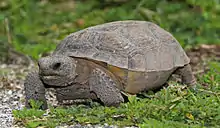 |
15.03861[31] | |
Geology
| Type | Symbol | Description | Year | Image | Statute |
|---|---|---|---|---|---|
| Gem | Moonstone | Moonstone does not occur in Florida, but after the Apollo 11 mission, in which astronauts launched from Cape Canaveral landed on the moon, the state legislature chose to commemorate the mission by designating the moonstone as the state gemstone.[32] | 1970 |  |
15.034[33] |
| Soil | Myakka soil | Myakka soil is the most widespread soil in the state. It is unique to Florida.[34] | 1989 |  |
15.047[35] |
| Stone | Agatized coral | Agatized coral, which is a form of silicified coral similar to petrified wood, is found in Florida near Tampa Bay and in the Withlacoochee River (Suwannee River) region. It is the only gemstone found in the state.[36] | 1979 |  |
15.0336[37] |
Culture
| Type | Symbol | Description | Year | Image | Statute |
|---|---|---|---|---|---|
| Anthem | "Florida (Where the Sawgrass Meets the Sky)" | 2008 | 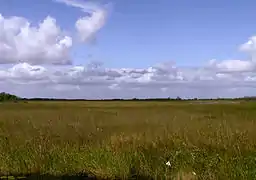 |
15.0326[38] | |
| Beverage | Orange juice | Oranges are the most valuable agricultural product of the state, and over 95% of Florida's orange production is processed, the vast majority of which becomes orange juice.[39] | 1967 |  |
15.032[40] |
| Festival | "Calle Ocho-Open House 8" | "El Festival de la Calle Ocho" (the Calle Ocho Festival) is a one-day rumba (fiesta) held at the end of the Miami Carnaval. The Calle Ocho Festival is held in March on Calle Ocho in Little Havana, Miami (Southwest 8th Street from 27th Avenue and 4th Avenue).[41] | 1980 |  |
15.0395[42] |
| Fruit | Orange | Oranges are the most valuable agricultural commodity of the state, which produces almost three-quarters of all oranges produced in the United States. | 2005 |  |
15.0315[43] |
| Citrus archive | Florida Citrus Archives | Housed at Florida Southern College in Lakeland, Florida, the Florida Citrus Archives are an extensive collection of citrus related materials, believed by many in the citrus industry to be the largest collection of its kind.[44] | 2001 | 15.0325[45] | |
| Pie | Key lime pie | Key lime pie (traditionally made with Key limes from the Florida Keys) is made with condensed milk, which does not require refrigeration, an important consideration in the Keys before the widespread availability of refrigeration. Prior to the construction of the Overseas Railroad, fresh milk was a rare commodity. Key lime pie made with Key limes (as opposed to Persian limes) is pale yellow, not green. | 2006 |  |
15.052[46] |
| Play | Cross and Sword | Cross and Sword, a pageant based on the play written by Paul Green, is a dramatization of the Spanish colonization of St. Augustine, Florida, the nation's first city. The stories of Pedro Menéndez, Jean Ribault, and Father López, some of Florida's earliest European settlers, are told.[47] | 1973 | 15.035[48] | |
| Rodeo | Silver Spurs Rodeo | The Silver Spurs Rodeo, which began as an effort to buy war bonds, is now billed as the largest rodeo east of the Mississippi River.[49] | 1994 |  |
15.0391[50] |
| Railroad museum | Gold Coast Railroad Museum | Founded in 1956, the Gold Coast Railroad Museum was built on the grounds of the former Naval Air Station Richmond in Miami, Florida. The Gold Coast Railroad Museum is one of three official state railroad museums in Florida.[51] | 1984 | 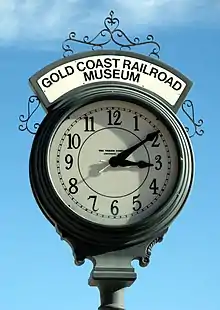 |
15.045(2)(b)[52] |
| Railroad museum | Florida Gulf Coast Railroad Museum | The Florida Gulf Coast Railroad Museum, in Parrish, Florida, is one of three official state railroad museums in Florida.[53] | 1984 |  |
15.045(2)(c)[52] |
| Song | "Old Folks at Home" | From 1913–1935, the state song was "Florida, My Florida," by Rev. Dr. C. V. Waugh, sung to the tune of "O Tannenbaum."[54] Stephen Foster named the song "Old Folks at Home" but it is often referred to as "Swanee River."[55] | 1935[A] |  |
15.0327[56] |
State quarter
 State quarter for Florida
State quarter for Florida
Notes
References
- "The 2010 Florida Statutes". Florida Legislature. Retrieved May 21, 2011.
- "Office of the Secretary of State". State of Florida, Department of State. Retrieved May 22, 2011.
- "Florida's Historic Flags:State Flag, present". Cultural, Historical, and Information Programs. Office of Cultural and Historical Programs, State of Florida. Retrieved May 21, 2011.
- "2010 Florida Statutes, Title IV, Chapter 15 section 15.012". State of Florida. Retrieved May 21, 2011.
- "2018 Florida Statutes, Title IV, Chapter 15 section 15.0301". State of Florida. Retrieved May 29, 2019.
- "How did Florida get its nickname, The Sunshine State?". State of Florida. April 8, 2009. Retrieved May 21, 2011.
- "2010 Florida Statutes, Title IV, Chapter 15 section 15.03". State of Florida. Retrieved May 21, 2011.
- "The Florida State Seal". Cultural, Historical, and Information Programs. Office of Cultural and Historical Programs, State of Florida. Retrieved May 21, 2011.
- "Florida State Symbols:State Flower". Cultural, Historical, and Information Programs. Office of Cultural and Historic Programs, State of Florida. Archived from the original on June 5, 2011. Retrieved May 22, 2011.
- "2010 Florida Statutes, Title IV, Chapter 15 section 15.031". State of Florida. Retrieved May 21, 2011.
- "2010 Florida Statutes, Title IV, Chapter 15 section 15.0345". State of Florida. Retrieved May 21, 2011.
- Anderson, Mickie (September 23, 2010). "Study: Florida panther population in better shape than before; still a long way to go". University of Florida. Archived from the original on August 13, 2011. Retrieved May 22, 2011.
- "2010 Florida Statutes, Title IV, Chapter 15 section 15.0353". State of Florida. Retrieved May 22, 2011.
- "Florida State Symbols:State Bird". Cultural, Historical, and Information Programs. Office of Cultural and Historic Programs, State of Florida. Archived from the original on June 5, 2011. Retrieved May 22, 2011.
- Daniels, Jaret C. (January 2008). "Featured Creatures: Heliconius charitonia". University of Florida Institute of Food and Agricultural Sciences. Retrieved May 22, 2011.
- "2010 Florida Statutes, Title IV, Chapter 15 section 15.0382". State of Florida. Retrieved May 22, 2011.
- Bridges, Andres; Bester, Cathleen. "Biological Profiles: Largemouth bass". Florida Museum of Natural History. Retrieved May 22, 2011.
- "2010 Florida Statutes, Title IV, Chapter 15 section 15.036". State of Florida. Retrieved May 22, 2011.
- "Sailfish". Florida Museum of Natural History. Retrieved November 18, 2007.
- "2010 Florida Statutes, Title IV, Chapter 15 section 15.037". State of Florida. Retrieved May 22, 2011.
- Florida Cracker Cattle, The Livestock Conservancy, retrieved May 29, 2019
- "2018 Florida Statutes, Title IV, Chapter 15 section 15.0527". State of Florida. Retrieved May 29, 2019.
- "2010 Florida Statutes, Title IV, Chapter 15 section 15.0526". State of Florida. Retrieved May 22, 2011.
- Deutsch, C.J.; Self-Sullivan, C. & Mignucci-Giannoni, A. (2007). "Trichechus manatus". IUCN Red List of Threatened Species. 2007. Retrieved November 18, 2007.CS1 maint: ref=harv (link)
- "2010 Florida Statutes, Title IV, Chapter 15 section 15.038". State of Florida. Retrieved May 22, 2011.
- "The State Saltwater Mammal". Office of Cultural and Historical Programs, State of Florida. Archived from the original on June 5, 2011. Retrieved May 22, 2011.
- "2010 Florida Statutes, Title IV, Chapter 15 section 15.0385". State of Florida. Retrieved May 22, 2011.
- "Loggerhead Sea Turtle (Caretta caretta)". U.S. Fish and Wildlife Service. January 19, 2011. Retrieved May 23, 2011.
- "2010 Florida Statutes, Title IV, Chapter 15 section 15.0386". State of Florida. Retrieved May 22, 2011.
- "2010 Florida Statutes, Title IV, Chapter 15 section 15.033". State of Florida. Retrieved May 22, 2011.
- "2010 Florida Statutes, Title IV, Chapter 15 section 15.03861". State of Florida. Retrieved May 22, 2011.
- "Moonstone: Florida state symbols". Cultural, Historical, and Information Programs. Office of Cultural and Historical Programs, State of Florida. Retrieved May 22, 2011.
- "2010 Florida Statutes, Title IV, Chapter 15 section 15.034". State of Florida. Retrieved May 22, 2011.
- "Myakka -- Florida State Soil". United States Department of Agriculture. Retrieved 22 May 2011.
- "2010 Florida Statutes, Title IV, Chapter 15 section 15.047". State of Florida. Retrieved May 22, 2011.
- "Gemstones: Chalcedony". United States Geological Survey. July 17, 2002. Retrieved May 22, 2011.
- "2010 Florida Statutes, Title IV, Chapter 15 section 15.0336". State of Florida. Retrieved May 22, 2011.
- "2010 Florida Statutes, Title IV, Chapter 15 section 15.0326". State of Florida. Retrieved May 22, 2011.
- "Commodity Profile: Citrus" (PDF). Agricultural Issues Center, University of California. Archived (PDF) from the original on February 22, 2010. Retrieved May 23, 2011.
- "2010 Florida Statutes, Title IV, Chapter 15 section 15.032". State of Florida. Retrieved May 22, 2011.
- "Calle Ocho Festival, A Special Day To Experience, Hispanic Culture in Miami". Archived from the original on March 9, 2017. Retrieved May 26, 2011.
- "2010 Florida Statutes, Title IV, Chapter 15 section 15.0395". State of Florida. Retrieved May 22, 2011.
- "2010 Florida Statutes, Title IV, Chapter 15 section 15.0315". State of Florida. Retrieved May 22, 2011.
- "2001 Florida Senate Bill Analysis" (PDF). Retrieved May 26, 2011.
- "2010 Florida Statutes, Title IV, Chapter 15 section 15.0325". State of Florida. Retrieved May 26, 2011.
- "2010 Florida Statutes, Title IV, Chapter 15 section 15.052". State of Florida. Retrieved May 22, 2011.
- "Florida Division of Historical Resoiurces". Retrieved May 26, 2011.
- "2010 Florida Statutes, Title IV, Chapter 15 section 15.035". State of Florida. Retrieved May 26, 2011.
- Jacobson, Susan (February 18, 2005). "Back in the Saddle: Even As Osceola County Changes Dramatically, Cracker Cowboy Culture Goes On, Epitomized By Silver Spurs". Orlando Sentinel. Retrieved May 20, 2011.
- "2010 Florida Statutes, Title IV, Chapter 15 section 15.0391". State of Florida. Retrieved May 23, 2011.
- "Gold Coast Railroad Museum website". Retrieved May 26, 2011.
- "2010 Florida Statutes, Title IV, Chapter 15 section 15.045". State of Florida. Retrieved May 23, 2011.
- "Florida Gulf Coast Railroad Museum website". Retrieved May 26, 2011.
- "Rev. C. V. Waugh". Alachua County Library District Heritage Collection. Retrieved November 18, 2007.
- "Florida State Symbols:The State Song". Office of Cultural and Historic Programs, State of Florida. Archived from the original on June 5, 2011. Retrieved May 21, 2011.
- "2010 Florida Statutes, Title IV, Chapter 15 section 15.0327". State of Florida. Retrieved May 22, 2011.
- Kleindienst, Linda (April 25, 2008). "Senate cleans up lyrics of state song". South Florida Sun-Sentinel. Retrieved May 22, 2011.
External links
- Florida State Symbols, from the Office of Cultural and Historical Programs, State of Florida
This article is issued from Wikipedia. The text is licensed under Creative Commons - Attribution - Sharealike. Additional terms may apply for the media files.